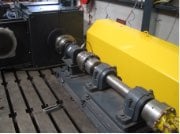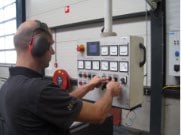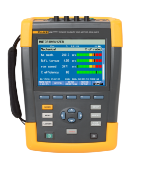
The Fluke 438-II: More than you imagined.
It isn’t magic. It isn’t a dream. It’s the pinnacle of engineering technology, and it is most certainly real.
You can accurately measure output torque in a motor without mechanical sensors.
Let that sink in.
It’s perfectly okay to feel a little wary about such a statement. After all, you’ve likely been measuring torque with mechanical sensors and they’ve never failed you. There’s no denying that the use of mechanical sensors does, in fact, work to measure torque in motors but it’s expensive and a hassle to set up, especially for motors that are in the field.

This shaft contains mechanical sensors, such as strain gauges.

The motor is taken out of service, moved to the test bed and connected to the shaft.

The motor is connected to a generator or dynamometer; load is applied in varying strengths.
When engineering is combined with motor-specific algorithms, you can finally measure torque without halting operation of the motor. It’s like making house calls to the motor for regular checkups, rather than bringing the motor out of service and into a lab. (Imagine how this factors into your Preventative Maintenance Program.)
Beyond convenience, the measurements are taken in the real operating conditions for the motor. This cannot be understated. This simplistic approach to motor performance measurement is much less invasive—on the motor and on the entire system it works in.

The tool that makes this type of measurement possible is called the Fluke 438-II Power Quality and Motor Analyzer. The 438 measures key mechanical elements, including speed, torque, and mechanical power—while the motor is in service—by using three-phase input measurements of voltage and current. All of this is performed without mechanical sensors. But don’t think sensor-less is senseless.
The 438 uses an algorithm that uses nameplate data as a starting point. Based on the algorithm used, the rated torque is calculated using the rated speed and the rated power. It’s all in the numbers—but not just Fluke’s.
Fluke sent a few 438s to DNV GL–a global quality assurance and risk management company–for an independent and external verification of claims. DNV GL performed measurements in different scenarios running the motor in clockwise and counter clockwise direction. Measurements were taken using the rated power in increments of 25% up to 100%. Torque was measured using the Fluke 438-II and a calibrated torque sensor and the results were compared.
The result: You can accurately measure output torque in a motor without mechanical sensors.
Fluke’s claim. Independently verified. Irrefutably true.
Consider this…
Algorithms are calculations used to measure, regulate, estimate, and predict a multitude of everyday activities and events. Consider how algorithms have impacted something as simple as the map. The digital maps we rely on today are connected to satellites and include real-time traffic information. Algorithms use the data collected to calculate estimated arrival/departure times and guidance to our destinations. We haven’t gotten rid of the map, just incorporated algorithms to improve its capabilities and accuracy for real-world use.
